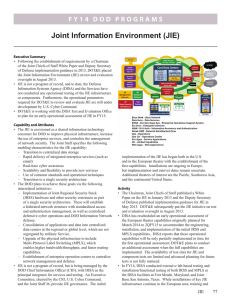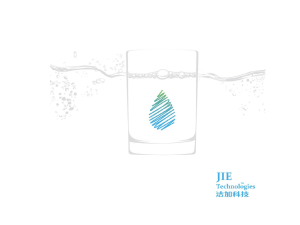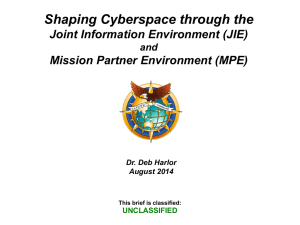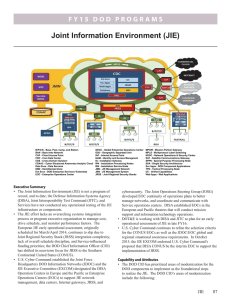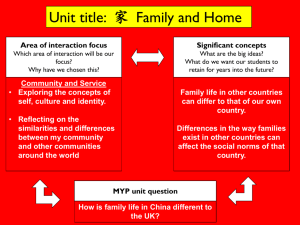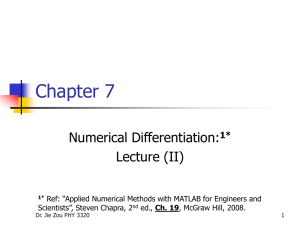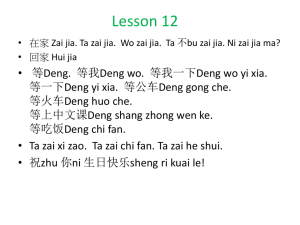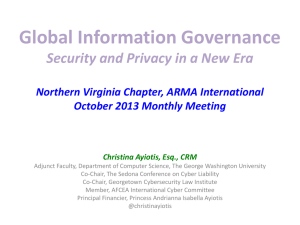JIE Way Ahead
advertisement
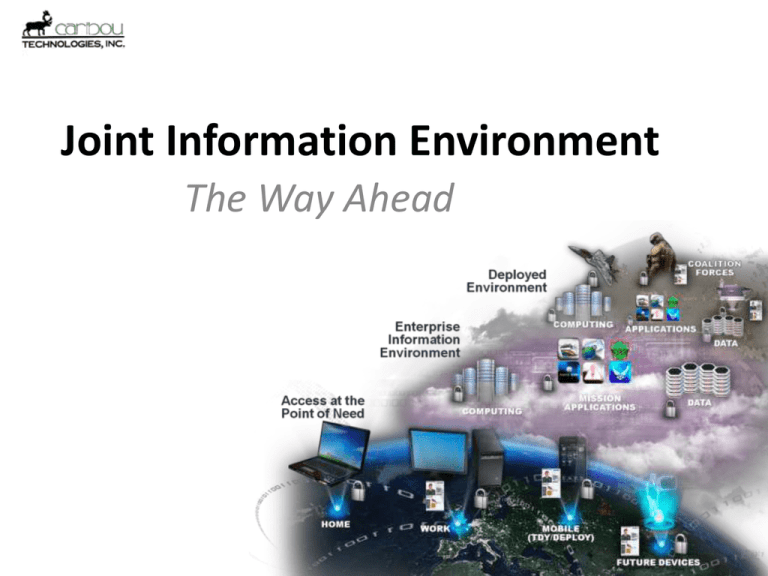
Joint Information Environment The Way Ahead Joint Information Environment What is it, anyways!? • • • • Joint information environment Shared IT infrastructure Enterprise services Single Security Architecture • JIE is NOT a Program of Record • JIE is NOT a turn-key solution • JIE is NOT an independent “way of doing things” – Uses existing architectures and services JIE Core Principles – the BIG Rocks • Joint Governance – “IT Task Force” • Network Normalization – Standardization • Data Center Consolidation – Reduced IT Footprint • Identity and Access Management – Trusted authentication • Enterprise Services – Email, collaboration, file storage, etc. JIE – What are we trying to achieve? • Improved Mission Effectiveness/Operational Flexibility – AGILE – Includes mobile, deployed – Works in Disconnected, Intermittent and Low Bandwidth • Increased Cyber Security – Confidentiality, integrity and availability – Works with ALL Mission Partners • IT Efficiencies/Joint Information Services – Interoperable – Maximum performance, reliability and extensibility JIE’s Three Lines of Operation 1. Governance 2. Operations 3. Technical Synchronization JIE JIERelationships Relationships DMAG Overall JIE Lead DoD JCS TANK 3 Star Programmers OPSDEPS JROC DAB/CIMB JCB OIPT/CCT CIO EB C4/Cyber FCB JIE EXCOM (Tri-chair: DoD CIO, JS/J6, CYBERCOM) USA, USMC, USN, USAF, NGB, USCG, USD/AT&L, CAPE, DISA, USD(I), USD(C), (AFRICOM, CENTCOM, EUCOM, NORTHCOM, PACOM, SOCOM, SOUTHCOM, STRATCOM, TRANSCOM) Planning/Coordination Cell (Tri-chair: DoD CIO, JS/J6, CYBERCOM) USA, USMC, USN, USAF, NGB, USCG, USD/AT&L, CAPE, DISA, USD(I), USD(C) - Ensure synchronization of the Department’sl JIE p an in coordination w/ Component activities Governance Task Governance Artifact C2 Cyber Task C2 Cyber Artifact Governance Lead Operational Sponsor - Develop, integrate, and synchronize JIE governance models & processes -Develop, integrate, and synchronize Operational procedures ISO JIE DoD CIO Engineering Task Engineering Artifact Implementation Task JIE Technical Synchronization Office Technical & Implementation Lead - Develop, integrate and synchronize JIE technical plans, programs, and capabilities and Execute JIE tasks Key Functions: USCC Supported Commander Governance Artifact C2 Cyber Artifact C/S/A Elements C/S/A Elements S/A Elements Implementation Task Develops DoD technical architectures Updates EXCOM via Planning/Coord Cell Synchronizes implementation activities with Transition Managers (C/S/A) Recommends solutions for fiscal shortfalls USA USMC USN USAF Synchronizes new capabilities & legacy IT sunsets Assesses transition Risk Synchronizes w/ IC Technology Enterprise USCG IC DISA NGB JIE Increment I EUCOM – Builds on existing network consolidation efforts – Heavily reliant on cloud architectures – Move Massive Application Silo’s to more flexible, responsive infrastructure Enterprise Operations Center Stuttgart, Germany JIE Increment 2 - PACOM As of 24 Apr 2013 JIE Increment 2 Approach Concept An integration strategy to achieve information capabilities that maximize mission effectiveness across the full spectrum of military operations with the full complement of mission partners. Information Products Information Consumers CHANNEL Information Miscreants Container Community MULTIPLE SECURITY DOMAINS SINGLE NETWORK INFRASTRUCTURE BY ALIGNING Information Producers Information Sharing Community Network and Enclave Channels COI Authorized Information Set Community of Interest (COI) Network Security Enclave (NSE) Information Control Domain (ICD) ACCESS CONNECT SHARE Common Core Services and Mission Partner Network 7 JIE Increment 2 - PACOM • Coalition capability “built-in” and not “added-on” • Common Mission Network Transport must support network security enclaves to accommodate many communities-of-interest to support user-to-user coalition connectivity • A wide-area neutral network is needed to connect the networks of sovereign nations • Robust identity authentication and authorization management for each nation to maintain trust in the system http://www.afcea.org/events/asiapacific/13/documents/JI E-Coalition-CIESLAK-131205Bv2.pdf • • • • • Discretionary Information Sharing Trusted personnel Identification and authorization service Agile virtual enclaves Information conditioning Strength of separation required http://www.referentia.com/ace/in dex.html JIE Challenges • Multiple Enterprises – Military Services, Intelligence Community, Agencies, CCDRS Multiple Partners, Allies, Coalitions, States, NGAs, OGAs, PVOs, etc. • Multiple Data Types – Public, Releasable, Private, Controlled, and Classified Information • Austere Connectivity Over Very Large Distances – Not just robust high-capacity public infrastructure • Mobile Forces & People • Huge Populations & Communities • Partners with varying levels of trust Upcoming JIE Event • JIE Mission Partner Symposium 2014 at the Baltimore Convention Center, Baltimore, Maryland from May 12 to May 14, 2014. Jesse Adams Chief Architect – US NAVY NGEN/NMCI, HP Enterprise Services • Jesse has been with HP (EDS) since 2007. • Jesse started as a Solutions Architect on the NMCI account, then became HP’s Chief Architect for the account in early 2010. • Responsible for working with the Echelon II commands to understand their objectives and help shape strategies. • He joins us from the Dallas Fort Worth area. JIE Challenges under NGEN • Not a Program – perceived as an “unfunded mandate” – Program Office may pick-and-choose elements of JIE to be adopted • LPTA Limits Innovation – Technology Refresh and Insertion Program will be largely responsible for moving existing designs into compliance with JIE, extending timeline for adoption over several years. • “Not Designed Here” Syndrome – Must minimize the “drift” likely to occur from differing opinions on how to apply JIE JIE Opportunities under NGEN • Adoption of SSA will help mitigate ever-increasing circuit strains – The introduction of the SSA at primary site boundaries will enable NMCI to stand down their Boundary 1’s, which are overloaded today largely due to media-rich Internet traffic. • On average, up to 90% of Internet traffic crossing the NMCI Boundary 1’s is MWR-related. – By facilitating Internet access closer to the users, the volume of traffic can be distributed across more points, reducing its impact on any individual WAN circuit. JIE Opportunities under NGEN • Server Farm Consolidation revisited – Move from a simple fork-lift approach to a modernization / transformation strategy • Consolidate to standardized platforms • Maximize virtualization for greatest service density – Move to a common reference architecture – potentially enable seamless migration of services between various data centers to meet evolving mission requirements. • Introduction of “XaaS” – Technologies reviewed/revised to better enable “confederation” of services and data, in order to better position them to best support the users. Jerry Bass Customer Solutions Architect – CISCO Federal • Jerry has been with CISCO since 1999. • Primary focus is Air Force. • He is an expert in network security and information assurance. • He joins us from the Boston area.
